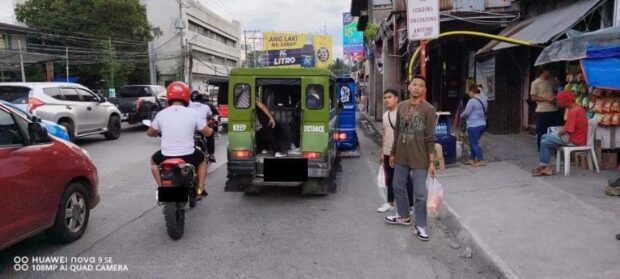Davao City set to phase out jeepneys by 2024

WAITING FOR A RIDE | Commuters wait for jeepneys to take them home in downtown Davao City, in this undated photo. Jeepneys will soon give way to buses with the Davao Public Transport Modernization Program set to start in 2024. (Photo from the Davao Region office of the Land Transportation Franchising and Regulatory Board)
DAVAO CITY, Davao del Sur, Philippines — The phaseout of the ubiquitous jeepneys from the roads of Davao City and their replacement with public buses starting next year will usher in “green commuting” in this premier urban center of Mindanao as it lessens the carbon emissions generated by the public transport sector.
According to a document from the Asian Development Bank (ADB), which is funding the Davao Public Transport Modernization Program (DPTMP) for $1 billion, the current mass transport system in the city of 1.8 million people, with public utility vehicles, more commonly known as jeepneys, as the main vehicles, has an estimated emission of 232,000 tons of carbon dioxide equivalent per year.
With the DPTMP, which costs some P73.3 billion, this emission level could be significantly lowered as 380 of the 1,100 buses to be deployed to cater to an estimated 800,000 passengers daily are electric-powered, which means it will have less air pollutants and greenhouse gas emissions.
The rest of the fleet will be Euro 5 standard diesel units, which also have lesser carbon footprints. The buses ranges from 12 meters to 18 meters long, and will be deployed to routes within the city and its immediate surrounding localities.
Meeting demand
The project is expected to contribute to the country’s commitment under the Paris Agreement on Climate Change of a 75-percent greenhouse gas emission reductions and avoidance target by 2030, ADB said. According to ADB, the city’s strong economic growth has increased the demand for travel across the expanding urban area that is mainly served by small vehicles, such as jeepneys.
Article continues after this advertisement“Public transport accounts for 80 percent of trips within the city but fails to keep up with changing travel demands and routing patterns because of fragmented ownership of vehicles and franchises,” ADB noted.
Article continues after this advertisement“As a result, severe congestion as well as vehicular pollution have been increasing, particularly over the last 10 years. Vehicular congestion has reduced travel speeds in the central business district of Davao City to less than 10 kilometers per hour at peak times. The opportunity cost in the form of lost income has also been increasing over time,” it added.The Department of Transportation (DOTr) said the project “will launch the Philippines’ biggest electrification initiative” in the public transport sector.
‘Very large leap’
President Ferdinand Marcos Jr., who witnessed the loan agreement signing between the government and ADB here on Saturday, said the project “heralds a very large leap to modernize our transport system.”
The DPTMP will rationalize the current 120 jeepney routes covering 670 km into only 30 bus routes; construct about 1,000 bus stops along bus corridors with shelters to protect passengers from the weather; implement minor road improvements, including identifying designated bus lanes for selected road sections; create queue-jump lanes for buses; build pedestrian crossings near bus stops and improve sidewalks near bus stops; establish bus priority traffic signaling and automatic fare collection system; and put up Wi-Fi connection in buses, terminals and depots, and other public waiting areas.
Comfortable commute
“As the country’s first integrated city-wide bus service, this landmark project promises a multitude of benefits for residents of Davao as well as tourists who frequent this beautiful city,” said Transportation Secretary Jaime Bautista.
“The DPTMP will see the establishment of the first of its kind public transportation system that would set the standard for safe, efficient, and convenient high-priority bus system. The project aims to provide a more comfortable commuting experience for all,” Bautista added.
There will also be increased passenger safety as they would take the vehicles on curbside doors, not on the back doors which requires them to walk on the carriageways of roads. Of the total funding for the project, 60 percent will come from ADB, 40 percent from the DOTr, and the city government will chip in P1.5 billion.
Marcos assured the government will assist displaced jeepney drivers and their dependents, and others who will be affected.
Families who will be affected by the construction related to the project will be also relocated if needed, the president said.
The project is set to begin by the third quarter of this year and will begin to be operational by next year and will be fully operational by the end of 2025.